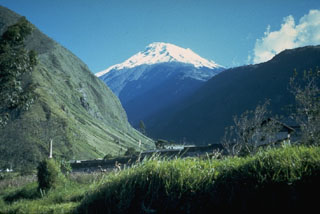Report on Tungurahua (Ecuador) — 30 October-5 November 2013
Smithsonian Institution / US Geological Survey
Weekly Volcanic Activity Report, 30 October-5 November 2013
Managing Editor: Sally Sennert.
Please cite this report as:
Global Volcanism Program, 2013. Report on Tungurahua (Ecuador) (Sennert, S, ed.). Weekly Volcanic Activity Report, 30 October-5 November 2013. Smithsonian Institution and US Geological Survey.
Tungurahua
Ecuador
1.467°S, 78.442°W; summit elev. 5023 m
All times are local (unless otherwise noted)
IG reported that, during the last week of October and the first days of November, moderate activity continued at Tungurahua; there were ~10 explosive emissions recorded. Plumes reached 800-2,000 m above the crater and drifted E and SE; ashfall was not reported from nearby communities. Seismicity included explosions, long-period earthquakes, volcano-tectonic earthquakes, and tremor (often associated with emissions). SO2 flux measured during this time period reached a maximum of 725 tons per day. Inflation and deflation trends continued to be detected by the tiltmeter network. Since August 2012 there have been six periods of general deflation each separated by 2-3 month intervals of relative stability.
Ongoing emissions were reported by the Washington VAAC on 30 October, primarily due to elevated seismicity. On 3 November, a pilot observed an ash plume at 8.5 km a.s.l. (28,000 ft); later in the day, ash was detected by the GOES-13 weather satellite as well as the local weather observatory and pilots. The ash plume reached 6.7 km a.s.l. (22,000 ft) and extended ~28 km SE.
During the evening of 4 November, IG observed an ash plume rising from the crater up to ~1 km a.s.l. and drifting SE. Cloudy conditions restricted observations on 5 November.
Geological Summary. Tungurahua, a steep-sided andesitic-dacitic stratovolcano that towers more than 3 km above its northern base, is one of Ecuador's most active volcanoes. Three major edifices have been sequentially constructed since the mid-Pleistocene over a basement of metamorphic rocks. Tungurahua II was built within the past 14,000 years following the collapse of the initial edifice. Tungurahua II collapsed about 3,000 years ago and produced a large debris-avalanche deposit to the west. The modern glacier-capped stratovolcano (Tungurahua III) was constructed within the landslide scarp. Historical eruptions have all originated from the summit crater, accompanied by strong explosions and sometimes by pyroclastic flows and lava flows that reached populated areas at the volcano's base. Prior to a long-term eruption beginning in 1999 that caused the temporary evacuation of the city of Baños at the foot of the volcano, the last major eruption had occurred from 1916 to 1918, although minor activity continued until 1925.
Sources: Instituto Geofísico-Escuela Politécnica Nacional (IG-EPN), Washington Volcanic Ash Advisory Center (VAAC)

